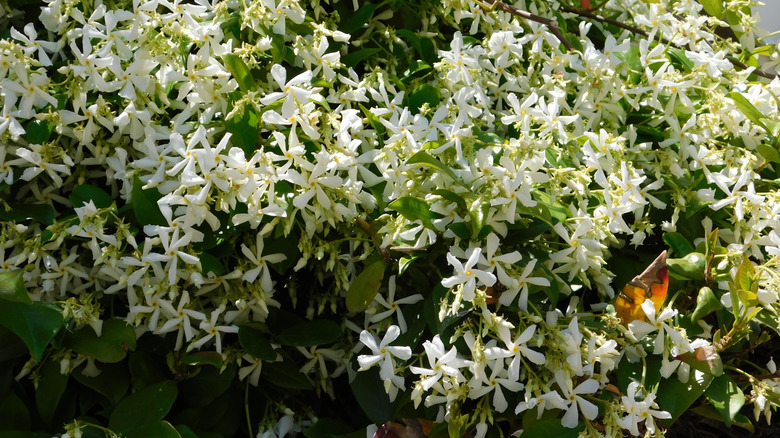Get Healthier Star Jasmine In The Spring With This Essential Fall Task
Composting, watering, mulching, pruning, and winter-proofing -– transitioning your garden from summer to fall is exhausting but rewarding, especially if you're growing an evergreen vine like star jasmine (Trachelospermum jasminoides). With its sweet fragrance, delicate star-shaped flowers, and versatile nature, this climbing plant will effortlessly blanket your yard with color. It's no wonder that many home gardeners strive to maintain their plants' lush green foliage and flower-bud growth throughout winter and into spring. The good news is, pruning, an essential fall task, can help you promote a healthy and prolific star jasmine next spring.
You might have heard that star jasmine doesn't require much pruning, and that is actually true, for the most part. However, due to the vigorous growth habit, this twining vine can easily reach over 20 feet tall. If this happens without adequate support, the branches may clump over one another, preventing sunlight from reaching older growth. The leaves of the covered branches will eventually start yellowing and drop. Sometimes, the plant starts to grow sparse tips and ends up appearing woody and dense.
That's why gardeners often recommend pruning star jasmine at least once a year, right after its flowering season, to stimulate healthy growth and an abundance of fragrant flowers. Depending on your climate, this could be May and June in warmer regions or August and September in cooler areas. If your plant grows rapidly, you can prune twice a year instead: a more aggressive prune in late summer, and another light prune later in fall.
Benefits of pruning star jasmine in early fall
Pruning your star jasmine at least once a year offers great benefits for your plant's overall health. By regularly pruning your plant, you prevent overcrowding, encourage air circulation, and help the plant stay balanced and productive. When you prune star jasmine right at the end of the flowering season, you give it enough time to recover before winter and ensure a fresh burst of healthy flowers when spring returns. It also reduces the chance of branches tangling or weighing down support structures. A gentle fall trim also helps open up the plant, allowing sunlight and fresh air to reach all parts of the vine.
Even though star jasmine is relatively disease-resistant, thinning its growth helps prevent pests and reduces the chance of mildew. Pruning also shapes the vine into a more compact, balanced form, which is especially helpful when growing star jasmine against a wall, fence, or other garden trellis structures. It also encourages the growth of thicker, stronger vines. By cutting back long or unruly shoots, you redirect the plant's energy toward developing fuller branching. By doing so, you can use this fresh-smelling vine for added privacy along your backyard fence or any other vertical structure in your yard. However, avoid pruning too late in the season, as this can accidentally remove the developing buds that form during winter and lead to sparse flowering in spring and early summer.
How to prune star jasmine
Pruning star jasmine is a fairly straightforward process. You don't need to know any advanced pruning techniques, and you can simply use a pair of sharp pruning shears, a hedge clipper, or even an electric hedge clipper — if you have a long star jasmine border. Make sure to wear gloves and long sleeves before you begin pruning because when cut, the plant secretes a milky sap that can be irritating to some people.
Begin the process by brushing off and removing any dead or damaged leaves. Grab a branch and start pruning at the bottom, then work your way up, especially if you have long, sporadic branches. You'll want to clip right after a leaf junction or node to encourage new shoots from that point. Always clip off a node or two first and then prune more if needed. When you're done pruning the lower parts of the vines, begin removing from the top parts enough so that the upper vines are not covering the middle growth of the plant. This will help you encourage sparse middle parts to fill in.
You'll also want to remove the stems that are twining onto each other to reduce the load of the branches on the support structure and improve airflow. Finally, move to the older growth underneath and remove all dead stems, ensuring that the sun can reach all parts of the plant. Once you're done, check that supports are secure and water the plant thoroughly if the soil feels dry.


